--------This thread has nothing to do with any 3 letter aiming acronyms! Keep them out of this thread. Thank you.---------
***Edit 2/19, I updated the pictures to remove an error brought to my attention later in the thread***
My intent of this thread is:
1. "Aim small, miss small". This means directing the OB to a specific place in the pocket that you can "see", instead of a big black hole.
2. Picking the appropriate place to direct the center of the OB based on its approach angle. Note, this is for "clean entry" into the pocket.
I put together the following pictures. I know the "center" of the pocket has been discussed throughout the years, but I have not seen pictures of ways to visualize it before. I've never aimed at a specific part of the pocket before, I just visualized the entire opening as a "black hole". Just a few days ago, I made a conscious effort to stand behind the OB, in-line with its path to the pocket, and pick out the center of the pocket. Then, pick a referece point of the pocket that is in line with this center.
The pictures below are for a GC4 table. I'm sure other tables will have similar features that can be picked out. Depending on the lighting on your table, will make the screw hole hard to see, but its there. I also found that depending on where the CB is, you sometimes can't see the inside of the pocket, so you have to look at features outside of the pocket. That's what the second picture is for.
I've been fooling around with this for a couple days now. I won't say its helped, because its too soon to rule out a placebo affect for me. However, I like that my eyes have a finite target for the center of the OB now. In fact, my eyes watch the center of the OB hit the target I selected. Its like this finer target is providing my subconscious fine tuning ability, and I simply watch the OB hit the target and let my subconscious take over. For you "Inner Game of Tennis" fans, you can use this concept to your advantage.
A few discussion points mentioned later in the thread:
Cheating the pocket:
To cheat the pocket, just pick a visual target that is close to where you want the OB center to hit, instead of the target that is in line with the center of the pocket from the particular approach angle.
Hitting the rail:
The effective center will move if you allow hittng the rail on the way into the pocket. I marked my examples for "clean" shots, as that is the way I want to practice. But you can obviously pick whatever visual target you want if you want to allow for hitting the rails on the way in.
Sorry some of the pics didn't turn out very sharp due to the file size limitations. If you want higher resolutions, PM me, and I'll send you the original files as a PDF.
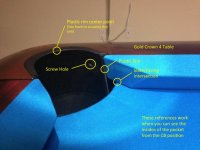
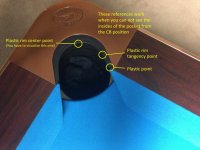
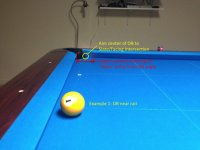
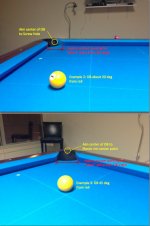
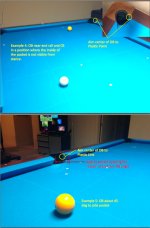
***Edit 2/19, I updated the pictures to remove an error brought to my attention later in the thread***
My intent of this thread is:
1. "Aim small, miss small". This means directing the OB to a specific place in the pocket that you can "see", instead of a big black hole.
2. Picking the appropriate place to direct the center of the OB based on its approach angle. Note, this is for "clean entry" into the pocket.
I put together the following pictures. I know the "center" of the pocket has been discussed throughout the years, but I have not seen pictures of ways to visualize it before. I've never aimed at a specific part of the pocket before, I just visualized the entire opening as a "black hole". Just a few days ago, I made a conscious effort to stand behind the OB, in-line with its path to the pocket, and pick out the center of the pocket. Then, pick a referece point of the pocket that is in line with this center.
The pictures below are for a GC4 table. I'm sure other tables will have similar features that can be picked out. Depending on the lighting on your table, will make the screw hole hard to see, but its there. I also found that depending on where the CB is, you sometimes can't see the inside of the pocket, so you have to look at features outside of the pocket. That's what the second picture is for.
I've been fooling around with this for a couple days now. I won't say its helped, because its too soon to rule out a placebo affect for me. However, I like that my eyes have a finite target for the center of the OB now. In fact, my eyes watch the center of the OB hit the target I selected. Its like this finer target is providing my subconscious fine tuning ability, and I simply watch the OB hit the target and let my subconscious take over. For you "Inner Game of Tennis" fans, you can use this concept to your advantage.
A few discussion points mentioned later in the thread:
Cheating the pocket:
To cheat the pocket, just pick a visual target that is close to where you want the OB center to hit, instead of the target that is in line with the center of the pocket from the particular approach angle.
Hitting the rail:
The effective center will move if you allow hittng the rail on the way into the pocket. I marked my examples for "clean" shots, as that is the way I want to practice. But you can obviously pick whatever visual target you want if you want to allow for hitting the rails on the way in.
Sorry some of the pics didn't turn out very sharp due to the file size limitations. If you want higher resolutions, PM me, and I'll send you the original files as a PDF.





Last edited: